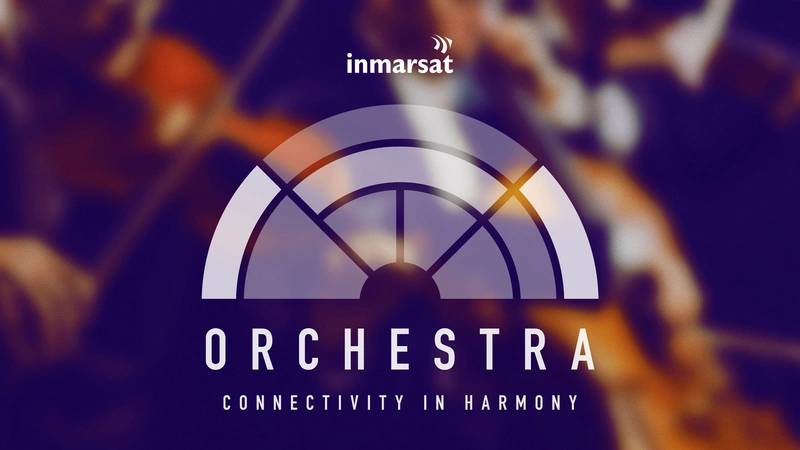The Satcom ‘Highway’ will Enable Maritime Digitalization & IoT Solutions
Global maritime communications powerhouse Inmarsat earlier this year announced a pair of new tech offerings – ORCHESTRA and ELERA – that are touted as ‘the communications network of the future.’ We caught up with Ronald Spithout, President, Inmarsat Maritime, for additional insights on how these services will power the future of maritime IoT.
As digitalization and IoT continues to drive innovation across the maritime sector, satellite communication will serve as the conduit, and smaller, faster and cheaper is the mantra. Inmarsat, which today garners approximately 50% of its revenues from maritime, anchored by its Fleet Xpress digital platform rolled out in 2016 and now on 12,000 vessels, continues to serve the role of innovator with the development of a pair of new offerings with promise to help shipowners further leverage the potential of online and digital solutions.
Meet Orchestra
“In my view, with an engineering background, (ORCHESTRA) is simply cool,” said Spithout. “We call it the communication network of the future because it will redefine our mobility offering in the industry, not only in maritime, but in all verticals. It is doing that by leveraging all kinds of underlying networks that we have at our disposal.”
Inmarsat ORCHESTRA is designed to be a “global, multi-dimensional, dynamic mesh network that will redefine connectivity at scale” as Inmarsat said when introducing it this summer. ORCHESTRA is envisioned to be a seamless configuration of Inmarsat’s ELERA (L-band) and Global Xpress (Ka-band) networks with terrestrial 5G, targeted low earth orbit (LEO) capacity, a layered approach supplemented by a ‘dynamic mesh network’, which allows individual terminals to act as nodes to route traffic to and from other terminals.
“Depending on where you are and what you need, the 5G element automatically picks up the best performance needed for your application,” said Spithout. Adhering to the adage there is power in numbers, “this will be a dynamic mesh network, whereby vessels are repeating each other signal,” similar to the way a home router handles WiFi.
The layered approach is designed to meet the accelerating bandwidth requirements of more diverse, demanding and ever more widely adopted applications in the commercial and government mobility markets, as Spithout explains Inmarsat is “targeting the markets that are absolutely dependent on mission critical mobility.”
ORCHESTRA is part evolution and revolution, as it combines the power of existing Inmarsat services and satellites, while adding the dynamic mesh technology and additional low orbit satellites as needed.
 Image courtesy Inmarsat
Image courtesy Inmarsat
Meet ELERA
In concert with ORCHESTRA, ELERA is designed to be a catalyst for increased IoT solutions across all vertical markets that Inmarsat services, including maritime and offshore energy.
“The drivers (for ELERA) are the accelerated demands on IOT and the ongoing growth of functionality where you need it for your safety services,” said Spithout, noting that the new technology is designed to be smaller, lighter, faster and cheaper, and confirms Inmarsat’s commitment to L-band services.
ELERA will be designed to create the smallest footprint, low-cost terminal for L-band users, according to Inmarsat “delivering the ideal framework for satcom IoT at scale with supporting cloud-based management.” Inmarsat is launching a pair of new satellites to enhance the ELERA network, with the first I-6 satellite scheduled to launch at the end of 2021. The I-6 satellites are significant as the L-band capacity on each I-6 will be substantially greater than Inmarsat’s 4th generation spacecraft and, among other enhancements, they will deliver 50% more capacity per beam.
The new innovations that Inmarsat is investing in include spectrum management technology to deliver L-band speeds up to 1.7Mbps, the smallest footprint, low-cost L-band terminal and two new L-band satellites.
The new spectrum management capabilities (known as Carrier Aggregation) being incorporated into the ELERA network will deliver the fastest speeds globally available to L-band customers, according to Inmarsat.
Live customer trials in commercial aviation are scheduled to start during the course of 2022 and the technology will be rolled out in the coming years.
 As digitalization and IoT continues to drive innovation across the maritime sector, satellite communication will serve as the conduit, and smaller, faster and cheaper is the mantra. Image courtesy Inmarsat
As digitalization and IoT continues to drive innovation across the maritime sector, satellite communication will serve as the conduit, and smaller, faster and cheaper is the mantra. Image courtesy Inmarsat
COVID-19: Digitalization’s Fast-Track and the Seafarer
The COVID pandemic has helped to fast-track IoT and digitalization trends in tandem, across all industries. And while Inmarsat is playing a pivotal role in this high-tech phenomena that is driving shipping and business efficiency, Spithout focuses first on digitalization as it applies to the human aspects, specifically the plight of seafarer.
As has been well-documented, COVID has had a dramatic, negative impact on the world’s 1.6 million seafarers, and a majority of countries have still not yet declared seafarers as “Key Workers”, a designation which would help to facilitate more efficient crew changes. The situation, which is easing now but is still pervasive, has taken a tremendous toll on the physical and mental health and welfare of seafarers, men and women who helped keep ships running and global commerce flowing during the pandemic.
“People tend to forget is that more than 90% of (most everything you purchase) is coming to you by a ship,” said Spithout. While it could never replace human interaction, Spithout said that throughout ships outfitted could use a digital link to provide connectivity for social interaction between seafarers and their families and friends, while also providing the conduit to quickly and efficiently deploy physical and mental health assistance. “This was a proof point that we, together with our application partners, could roll it out quickly to vessels while they were at sea. That is one side of digitalization that had an enormous boost because of COVID, but it's not a good one because it came over the back of seafarers suffering.”
In looking at the myriad of companies that generate their revenues by physically being in touch with the ship, the rapid advance of COVID effectively thwarted this basic connection, forcing companies and stakeholders to find alternate ways of working. Enter IoT.
“In the beginning of the pandemic, a lot of those vessels couldn't be ‘touched.’ You couldn't get to the vessel,” said Spithout. “It made people aware that not only do they need a different way of working to circumvent the fact that they couldn't physically visit vessels, and also that you can change the way you provide your services by the smart use of applications over a digital platform,” touting for instance the fast-track of classification societies’ use of remote inspection technologies.
- Watch the full interview with Ronald Spithout, President, Inmarsat Maritime, on Maritime Reporter TV














